The Battle between the Mower and the Grower
Posted on Tuesday, July 5, 2022 · Leave a Comment
In most households, one person is the gardener, and another takes care of the lawn. Or perhaps a hired service or teenager does the mowing and string trimming. But it is common that there is conflict between the two parties. There are ways to minimize the problems if both parties are willing to compromise – and perhaps do a little extra work.
The mower generally wants to get the job done quickly. There are other things to do in summer – other lawns to mow, ponds to swim in, or hammocks to doze in. What can the gardener do to help the mower?
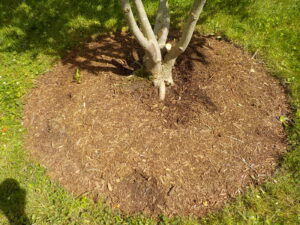
Keep mulch from touching the tree. This ring will keep mowers and trimmers away from the trunk.
First, create a nice mulch ring around trees and shrubs. This will accomplish a couple of things: it will protect the bark of a tree from damage by a string trimmer. And it will hold in moisture and keep down weeds, benefiting the tree. For the mower, it will speed up the process of mowing round the tree and may even obviate the need to use the string trimmer. But never let the mulch touch the tree – it can cause it to rot, eventually killing it.
What else can the gardener do to help the mower? Remove low hanging branches. Apple trees, among others, often have low branches that reach out way beyond the circumference of the mulch ring. And yes, it is nice to be able to pick apples of those low branches, but do you really need them at the three or five-foot level?
Quite frankly, I think trees look better if the lower branches are removed and the bark of the trunk is on display. Many trees have nice looking trunks with interesting bark. I like to see the “legs” of a shrub or tree.
And what can the mower do to help the gardener? Blow the grass away from the flower or vegetable beds. There are few things more annoying than weeding and mulching a flower bed, only to have a person with a mower blow grass and perhaps dandelion seeds into the bed. And yes, I have seen professionals then blow the grass off the bed, but it is so much easier (and quieter) to just point the mower so that it blows the grass away from the beds.
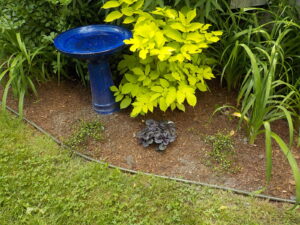
Keep hoses off the lawn where you can
Then there is the issue of hoses. Mowers generally do not want to be bothered disconnecting hoses that cross the lawn. They say that a mower with blades set at three inches should clear the hose, running right over it safely. But sometimes the front wheels of the mower will somehow push the hose up. And then the hose can be damaged.
So what can you do? If you are depending on a hose for regular watering of new trees or perennials, you probably need the hose to cross the lawn so it can be used every day or two. Think about burying the hose. If you are crossing a section of lawn that is heavily traveled, you may wish to dig a six-inch deep trench and slide the hose inside a section of plastic pipe.
To avoid having to re-seed the trench, use an edging tool to slice through the grass and lift strips if sod out carefully and set them aside. Dig a shallow trench and after pushing the hose through the pipe and placing it in the ground, cover the pipe with some good top soil. Then take the sod and fit it back where it was before.
The advantage of the pipe system is that you can pull the hose out of the pipe if it develops a leak, or if you want to put it in the barn for the winter. Quite frankly, I don’t think you need to bother with a pipe – or even burying it completely. Just take your edging tool or a straight-bladed shovel and slice into the lawn. Pull the handle back and forth, creating a “V” in the grass. Push the hose into the “V” and step on it. Push hard enough so that the top of the hose is not sticking up into the grass, but is right on the soil line. As the grass grows, you will not see the hose. I have done this, and left hoses in the ground for years with no ill effects.
People who mow, generally, also like to string trim the edges of beds and around trees. A common mistake is to trim the edges too close to the ground, “scalping” the grass near the flower beds. I have no suggestions on how to avoid this, except to politely ask the mower NOT to trim so darn close. Maybe growl a little.
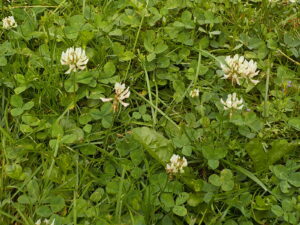
Clover in the lawn is good for bees and pollinators
Then there is the question of how often to mow. People who mow commercially like to have a regular schedule, and as often as possible. But if your spouse or child is the mower, point out to them that you want to let the grass get a little taller before mowing. Explain that the Dutch white clover that only blooms when the lawn is a little long is much loved the bees and pollinators. Get them to think of the lawn as the lunch buffet for bees.
If you set the mower at three or four inches, your lawn will thank you. Yes, I know that the infield of Fenway Park is cut at less than an inch, but your half acre of lawn need not be. Grass plants need to feed their roots so they can grow deep into the soil – where the moisture is in dry times. The longer each blade of grass, the more food it can make by the miracle of photosynthesis.
If you keep your lawn longer, it will compete better with crabgrass and weeds. And you will get used to seeing it longer, and like it – or at least I do. You should not think it is a sign of indolence to have a lawn that doesn’t look like a green buzz cut.
Steps You Can Take to Ensure Your Trees Survive and Thrive
Posted on Monday, November 23, 2020 · Leave a Comment
I’ll have to admit that I see many fewer volcanoes of mulch snuggling up to trees in public places. I think the word is out, at least with municipal workers, that trees can be damaged or killed by over-exuberant mulching. Among homeowners? I’m not so sure. Let’s take a look at the problem.

Don’t create mulch volcanoes like this. 003
Tree bark is wonderful stuff: no matter the weather, bark protects its tree from rain, snow, cold or drought. But it is only rated for above-ground use. Bury tree bark, or cover it with mulch, and microorganisms will break it down and attack the green layer of cambium beneath the bark.

Tip die back due to damage to trunk flare
So what is this cambium layer? It is an active, growing layer of cells that produce the phloem and xylem tissue that provide for the transportation of necessary liquids and that provide mechanical strength. If the cambium layer is destroyed, the tree will die – but not right away. Most experts say that if the cambium layer is compromised, it can take six to ten years for a tree to decline and die. First signs of the problem include tip dieback – top branches losing leaves – and earlier fall color than previously seen.
When you mulch around a tree, you should leave space between the tree trunk and mulch. Some say, leave a donut hole around the tree. How much? Four to six inches is good, depending on the size of the tree. Bigger tree, bigger space. And even if you have started with a mulch-free space around the tree, don’t assume there is still a space. Go look. Gravity works 24/7, and rain and wind can move mulch a little.
Don’t get me wrong: I am not against mulching around trees. It serves two important functions. It keeps down weeds, and it keeps away exuberant guys (usually) with weed whackers. No mulch? That guy with ear protection and a raging string trimmer can girdle your tree in a heartbeat. And that would be as bad as letting mulch slowly rot the bark.
By pulling away the bark mulch, you can save the tree. I have removed mulch and seen damaged bark. But if the cambium is still functioning, the tree can recover, and I’ve seen that, too.
There is another way that the cambium layer can be compromised: covering the trunk flare with soil at planting time. Burying the portion of the tree that should be above ground will lead to a slow death.
Growing trees is an industry. Americans buy hundreds of thousands every year. They are sold at family-run nurseries and big box stores, but often started in nurseries in the warmer regions of the United States. Trees are often grown in fields, like corn, and then lifted and potted up to be sold to your local nursery.
If you ask how deep to plant your little tree, the most likely answer (from my informal survey of homeowners) is “Plant it just like it is in the pot.” But that is generally bad advice. The process of taking a field grown tree and getting it into a plastic pot is not precise. Time is money, so trees are often plunked in containers with little regard for the depth they were growing in the field. The trunk flare (that part that should be above ground) is often buried.
To recognize the trunk flare of a tree, go outside and look at a tree planted by Mother Nature. You will see at the base of a tree that there are above-ground roots heading away from the tree, and that the base of the tree widens just above ground level. That wider portion is the trunk flare, and must be above ground.
Before planting a tree, take your fingers and pull away the soil from the tree trunk at the surface until you can see the trunk flare. If the tree has been in the pot for a few years (often the case for larger trees) and the flare has been covered, little roots have started to grow out of the trunk flare, and should be cut off.
Larger trees for sale at nurseries have often been moved from their original pots or bags to larger ones. At that juncture, soil is added, and often covers the trunk flare. I have planted trees that came from the nursery with four to six inches of soil over the trunk flare. By removing that, I saved the trees.
What should you do if you planted a tree without regard to trunk flare? Take a look at it carefully. If your tree trunk is as straight as a telephone pole at the soil surface, you need to do some digging. You need to expose the trunk flare.

I have removed 2 inches of soil to expose trunk flare, but need to remove more
I like to use a single-tine hand tool called the CobraHead weeder ( www.CobraHead.cm) to expose the trunk flare. I gently and slowly loosen soil and pull it back with my hands. In fact, I use my fingers as much as possible, as I don’t want to damage the bark on the trunk flare. Once you see the flare, re-grade the soil around the tree trunk. It is not as scary a proposition as it sounds. You can do it.
Trees are our friends. It’s not enough to give them a hug from time to time (as I have been known to do, on occasion), you have to be sure they are properly planted and tended. So go outside and look at yours. You may have to do some work on the next warm day.
What Does a Gardener Do When the Rodents Are Out to Get Us?
Posted on Wednesday, October 24, 2018 · Leave a Comment
Like the Joad family in Steinbeck’s Grapes of Wrath, countless squirrels are on the move. Heedless of traffic, they cross the road in search of new sources of food. Steely-eyed gardeners bear down on them, thinking revenge for the destruction of their crops, particularly tomatoes, apples and pumpkins.
Last year was a “mast” year, meaning that our oaks produced a huge crop of acorns. This fed our squirrels, allowing them to produce more babies. We also had good snow cover last winter, which meant that rodents could hide from owls and hawks.
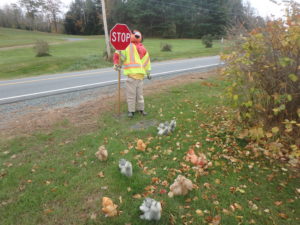
Squirrels need a crossing guard
Voles and mice are not often seen squished on the road, but other signs are evident to me: when I harvested my carrots and potatoes, for example, many had been chewed. And a grand influx of mice into homes has been reported this fall. What can you do to protect your plants and your harvest from all these rodents?
First, if you have fruit trees that are young, you should protect their trunks against rodent damage. Voles, those stocky, short-tailed mouse relatives are the worst culprits. They can reach sexual maturity in just 5 weeks after birth, so they can increase in numbers exponentially, given the right conditions. If hungry enough, they will chew the bark off young fruit trees, killing them by damaging the tender cambium layer all around a tree, girdling it.
To prevent that from happening, you can physically keep the voles away with fine-mesh screening called quarter-inch hardware cloth. It comes in 18- and 24-inch rolls, and I recommend the wider roll. A single layer of mesh screen around the base of the tree will keep the voles a bay. Remove the wire next spring to keep it from getting swallowed up by the bark as the tree grows (that would take a few years, but I’ve seen it happen).
Also available are plastic protectors. Some are tubes slit up the side, others are rolls of plastic to wrap around young trees to protect them from rodents. If your young tree has branches in its lower 2 feet of trunk, you will have to prune off those lower branches to fit the protectors. Mature trees have bark thick enough to deter the rodents.
A few words of warning: do not leave those plastic protectors in place forever. I’ve seen trees damaged by them when left on for a few years – the bark can rot, just as it will if buried in mulch.
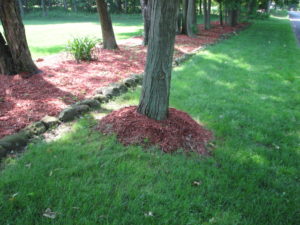
Don’t create mulch volcanoes like this
As you get ready for winter, check the mulch you may have placed around trees to keep the grass from growing up around them. “Volcanoes” of mulch around trees can be lethal. Mulch holds moisture and often harbors fungal pathogens that will destroy the bark your trees. Instead of a volcano of mulch, create a “donut” of mulch. Leave a few inches of free space around your trees.
While checking the mulch around your trees, also look for the trunk flare. At the ground level you should see trees widen and “flare out”. In mature trees in the forest you will see what appear to be fat roots appear at the foot of the tree, roots that disappear into the soil.
If the flare in a tree you planted is covered with soil, it will damage the bark – and in 6 to 10 years it can kill the tree. You can save your trees from a slow death by pulling back the soil from the base of the tree, exposing the trunk flare.
Moles are commonly blamed for all kinds of atrocities, but they do not eat your plants. They are carnivores that eat grubs and earthworms. If you have a Japanese beetle problem, they will help you by eating the beetle grubs. But in winter or spring moles often cause problems by digging up soil and leaving mounds on the lawn. There are castor oil-based repellents that will discourage them. I do not recommend poisoning them as pets and wildlife can be injured or killed.
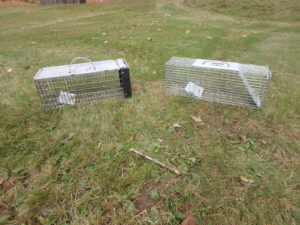
Humane traps are not always humane
Given the high squirrel population you may wonder if you should deport some before winter by trapping them with Hav-a-Heart type humane traps. Probably not, if you care about their well-being. According to what I have read, relocating rodents is not really humane. In a new location they are not likely to survive very long. They will either be eaten by predators or die of starvation.
As to the influx of mice in your house, there really is little you can do besides set traps – either humane ones, or snap traps. But if you store potatoes and carrots in a cool cellar, as I usually do, protect your food from mice and rats. The easiest way to do that is to store them in a second fridge. To keep them from drying out, put them in an open plastic bag with holes punched in it. Potatoes and carrots need to breath in storage. Check them from time to time, and eat them up before they go bad.
We share this planet with our little rodent friends, and I do brake for squirrels. Still, I do all I can to keep them from sharing my harvest or eating my plants.
You may reach Henry at henry.homeyer@comcast.net or by mail at PO Box 364, Cornish Flat, NH 03746. Please include a SASE if you write Henry and want a response by US Mail.











